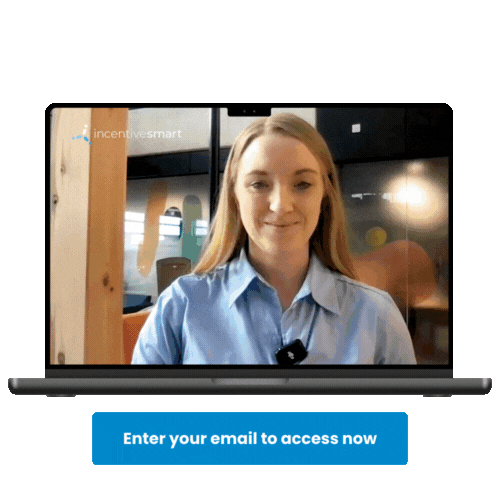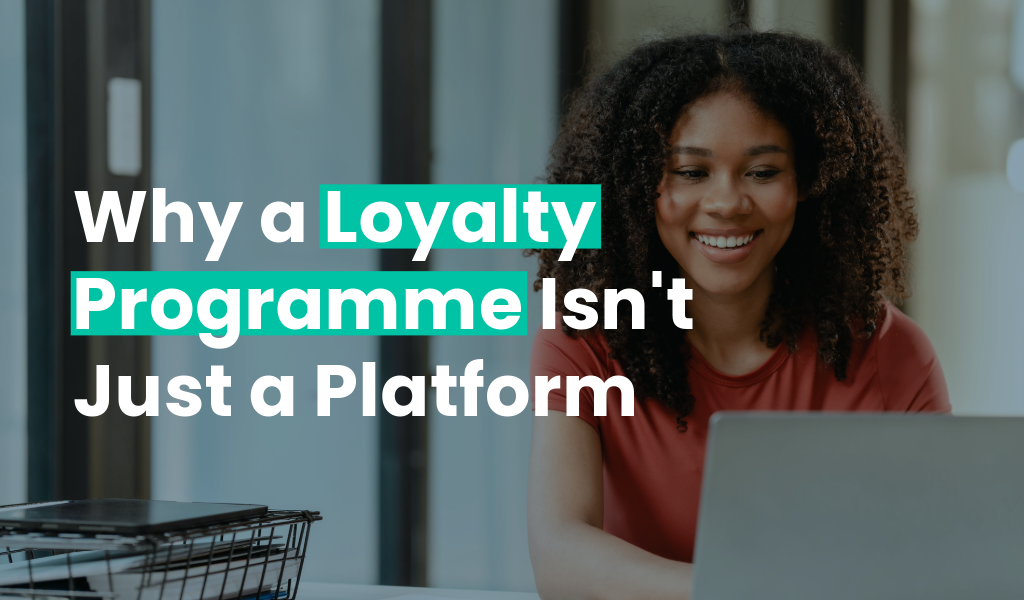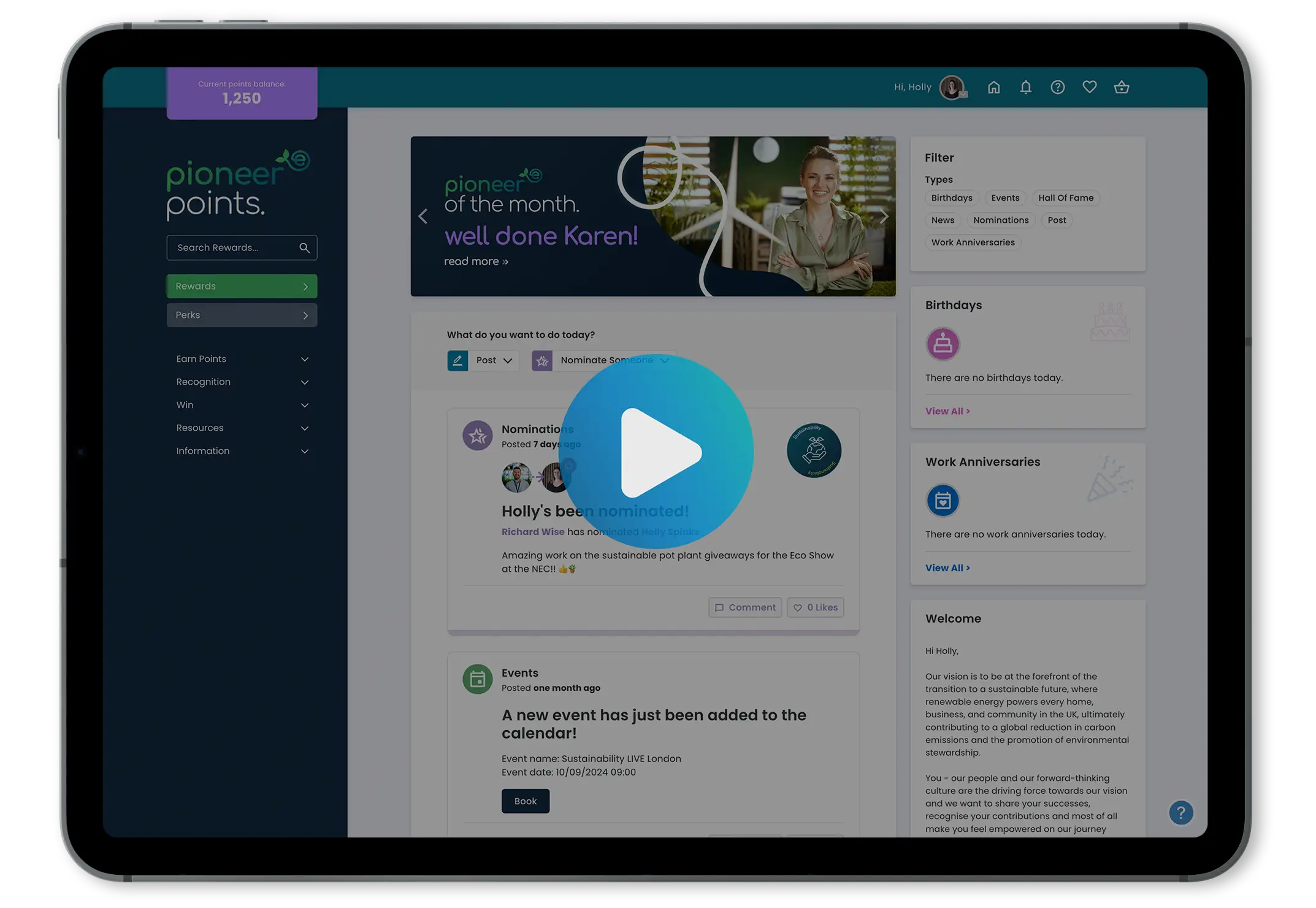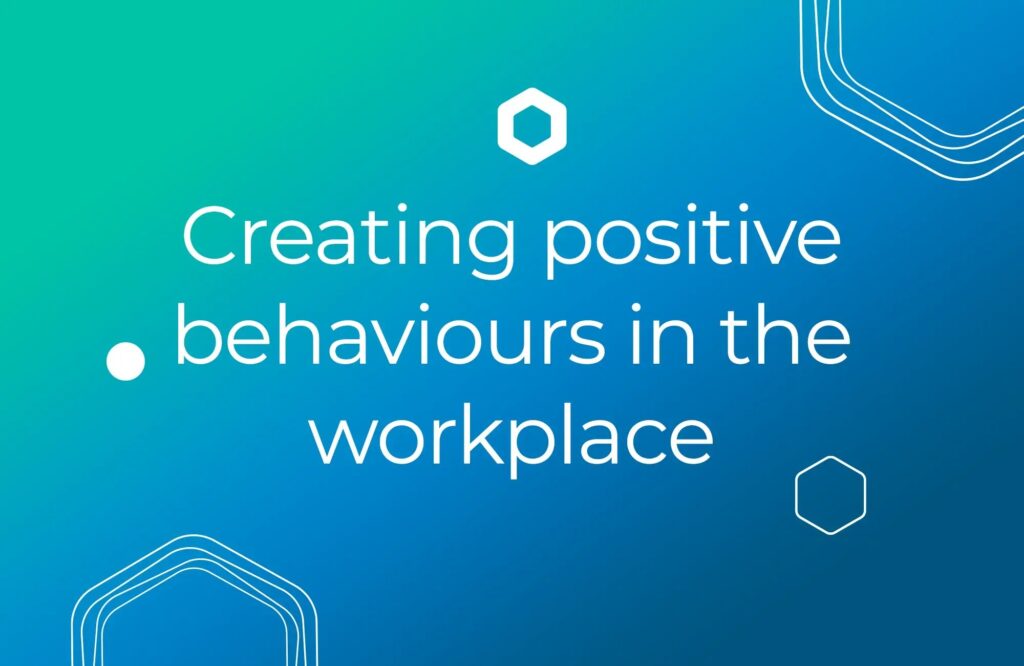


An employee reward scheme is vital in shaping company culture and ensuring employees are satisfied in their roles. A thoughtfully designed reward system can work wonders: it can lift spirits, enhance productivity and foster a positive and supportive work environment.
Because, when employees feel valued for their efforts, they’ll be highly engaged and productive.
However, creating an effective reward scheme for your staff is not without its challenges.
The key is to design a scheme that ensures that every employee – regardless of their role or level – feels appreciated. Which means striking a healthy balance between offering incentives to drive performance and providing non-financial recognition that genuinely resonates with employees.
To strike this delicate balance, a one-size-fits-all approach rarely works, as different employees are likely to respond well to different types of rewards.
So, here’s how to set about creating (or upgrading) your employee reward scheme…
Skip to:
6 ways to encourage positive behaviours you wish to reward in the workplace
By creating a strong and positive workplace culture, you will have a good foundation to encourage positive behaviours from your team, which can then be rewarded.
Here are some ways you can proactively incorporate the culture and inspire the
behaviours you wish to see in your team:
 Communicate the behaviour you want to see
Communicate the behaviour you want to see
Your core values should highlight the behaviours you want in your entire organisation, but this needs to go further than having them displayed on office walls. To breathe life into your core values and guide staff towards the expected behaviours, create processes that encourage these values.
For example, if you expect your staff to always be learning, provide training opportunities or incorporate personal development time into their schedules. If creating a culture of openness and honesty is a top priority, then lead from the top – make sure all organisational news is communicated clearly and timely through regular town hall meetings or internal newsletters.
Your employee reward platform can help you to award points to employees who engage with the behavioural objectives you set them and continue to do so long after the launch of the platform.
 Hire people with the right values and attitudes
Hire people with the right values and attitudes
Within your hiring process, make sure you are actively looking for the positive behaviours you want. Ask questions that relate back to your core values and ask for examples of when the candidate has demonstrated them.
Although skills can be learnt, having the right attitude to fit your needs and the existing team cannot. So, if during the hiring process, you don’t feel confident that they have displayed the behaviours you want to see, don’t proceed with them any further.
Bringing in staff that do not share your core values will not only cause disruption to the culture around them, but can also spread through the team and rub off on otherwise engaged members. With 89% of hires failing due to attitude, ultimately this person will soon move on, maybe taking others with them. This will only lead to more hiring and training resources to replace them.
 Model the behaviour you want to see
Model the behaviour you want to see
Employees will naturally take cues from their management team on how they are expected to behave. If your senior team has bad habits, such as working through their lunch, complaining about customers or not following processes and procedures, this will trickle down to the team very quickly.
It’s likely that some of these bad habits are deep rooted, and your senior management team may require training and re-education to cement the new and desired behaviours. This effort will also give them perspective on why the previous methods may have been detrimental and how improvement and refocusing on a healthier company culture can impact their team’s performance.
 Monitor and observe
Monitor and observe
Start by carrying out regular one-to-ones. Recognising and acknowledging hard work and positive behaviours observed between your meetings can help employees feel seen and valued. Not only does this help with their own engagement and satisfaction within their role, but managers will also be able to reinforce those behaviours by highlighting them and showing that they are appreciated. You should also pay attention to the moments when employees are in the act of doing something great, you can reinforce that positive behaviour immediately by recognising and rewarding it.
However, this recognition doesn’t just have to come from the senior management.
Thanking team members for their hard work and praising your team in either a private or a group environment will also encourage peer recognition. When co-workers are able to say thanks or well done to other members, the sense of being part of a team grows with it, while it also allows managers to see other areas that members of the team may be excelling in that could otherwise go unnoticed.
 Understand the cause and motive
Understand the cause and motive
If a team member’s behaviour has become more negative, there will likely be an underlying cause. Taking the time to speak directly to them can open up the communication and allow you to explore what is actually going on and choose the right actions to move forward.
A common reason for disengagement can be a feeling of monotony in their daily activities. Are you providing your team with enough challenge in their role? Employees can also become frustrated if they are not given the training they need to perform well or the right resources to do the job correctly. Speaking to your team and discovering the blockers they are experiencing will allow you to explore solutions together, so they leave feeling valued and listened to.
 Reinforce the right behaviours
Reinforce the right behaviours
Change doesn’t happen on its own. If you want to see more of the right behaviours within your organisation, positive reinforcement is an extremely powerful and simple concept to implement: If you reward employees for the desired behaviour, it is more likely to be repeated.
Since many of us will spend up to one third of our lives at work, having the opportunities to develop professionally, tackle stimulating challenges and feel valued for our contributions is essential.
When staff simply feel appreciated for their hard work, they are more productive and motivated as well as less likely to leave. From simple thank-yous to a more structured reward and recognition programme, definitions of the rewardable behaviours should be communicated clearly and provided on a fair basis. Nothing is going to kill a happy workplace culture more than feelings of favouritism or miscommunication of what “going the extra mile” means.

How employee reward schemes can encourage positive behaviour
If you want employees to behave in a certain way, then you need to ensure that your workplace breeds a culture that supports, encourages and holds your staff accountable to these expectations.
Rewards are a perfect way to support this initiative.
When employees are acknowledged, or see others being rewarded for particular behaviours, they are going to be motivated to repeat these behaviours moving forward.
If behaviour changes are needed within your business, make sure these are communicated to all levels of staff and, when changes are made, be sure to recognise even small improvements. It can be difficult to break habits, so positively reinforcing the changes a person has made towards their goals will help keep them motivated to continue.
How to use employee rewards effectively
Rewarding your team doesn’t always need to come in the shape of money.
Although bonuses are always going to be welcomed by your employees, sometimes something more creative can have the same positive effect, which is a relief if budgets are a bit tight.
Research shows that 80% of cash rewards get used toward household bills, with only 20% going towards an actual reward. Furthermore, it’s questionable whether cash rewards promote desired behaviours, as studies have shown that there is no correlation between cash reward and increased motivation or productivity.
Depending on your budget, non-financial rewards could include anything from a dedicated parking spot to team meals, or drinks to celebrate the end of a project or a high performing month. Helping co-workers recognise each other’s hard work is also a great way to make sure no one is taken for granted.
Whatever reward you decide to put in place, you’ll want to ensure that you also get the timing right. Delaying the reward can leave your team feeling ignored and frustrated, which can easily spread across the team if left unchecked.
So, what’s the best way to put this into practice?
Encouraging peer-to-peer recognition is a great way to introduce reward and recognition within your team. Having your team nominate their fellow colleagues for “employee of the month”, or a system that allows for personalised recognition between colleagues directly, can all contribute to a strong and powerful reward and recognition programme.
You can further emphasise your company values by encouraging employees to nominate each other when specific company values are exhibited. What’s more, if you are using a platform such as Incentivesmart, line managers will be able to see these messages of praise and reward the individual further.
Visual recognition is also essential. Sending a physical or e-card to say thank you, or delivering a monetary reward such as a voucher can prompt some friendly competition within the team. The more visible these rewards and acts of appreciation are throughout the business, the more likely that team members will want to get a piece of the action.
If gifts or vouchers are used to reward your staff, make sure they are relevant and personalised for the recipient. Be certain they are aware of what behaviour they are being rewarded for and gift them something they’ll find valuable. Whether it’s a voucher for a shop they really like or a bottle of wine you know they’ll enjoy, adding a bit of thought behind the rewards will mean so much more than a generic gift. Implementing an employee reward platform through an experienced partner can give you access to a wide range of goodies that allow recipients to choose the type of reward they truly want, thus having a much greater impact.
Any employee reward programme will ultimately be successful only when every individual understands what they are working towards.
Setting clear goals that are monitored and reviewed regularly will help your team see their progress over time and feel valued for their hard work.
As the positive behaviours you are hoping to cultivate become embedded in the day-to-day activities of your team, expand your goals further to keep your team moving forward and your company culture growing in the right direction.
Streamlining the reward process
Timing is everything when it comes to making your employees feel valued and appreciated.
However, when you’ve got a to-do list as long as your arm and deadlines are looming, maintaining cooperative, relationship-building processes may become negligible.
If you want to actively improve behaviours such as increased sales performance, as well as reduced absenteeism and staff turnover, you need a process that is simple to use with minimal management. Incentivesmart is the leading online points-based employee reward platform that will let you reward, track and motivate your employees through social recognition, goal chasing and continuous feedback.
With a reward catalogue that features something for everyone and is regularly updated with the latest and most inspiring treats, you can say goodbye to sending out the same generic gift card to every employee of the business. Instead, users can choose the rewards that they want, which they’ll in turn work harder for. What’s more, the reward is instantaneous, with users receiving the points as soon as they’re awarded. They can choose to spend them right away, or save them up for a stretch goal.
On the platform, you’ll also be able to communicate your mission, vision, and values while being able to give and receive personalised recognition through badges and nominations. This allows colleagues to share in each other’s success.

Practical steps to creating an employee reward strategy
To help you get your very own employee reward strategy up and running, we’ve put together the seven steps we recommend our clients follow…
 Define success
Define success
For a successful reward strategy, it’s vital that it is designed to help you reach the goals of your business and deliver on your mission statement. What challenges are you trying to solve, and what does success need to look like for your business? During these planning stages, you’ll want to check that the solution you move forward with will help align your employees’ behaviour with your brand values.
Setting out clear and concise goals for your programme will enable you to measure its effectiveness and improve any elements if necessary.
 Identify behaviours
Identify behaviours
What behaviours are important to your business? As a starting point, look at your core values and establish what behaviours are necessary to actualise your company culture goals.
Then, you’ll need to decide how to reward these.
With Incentivesmart, employees are able to collect points through displaying these behaviours, the points can then be put towards a reward of their choice.
For example, you could enable peer nominations, provide ad-hoc points rewards, or even ask employees to take part in a value-related quiz. With a range of approaches available, you can motivate and bring out the best in your team by just pinpointing the behaviours you wish to see more of.
 Understand your audience
Understand your audience
Each person in your business will be motivated by different factors. Some may want to reach their goals so that they can spend their points on a chosen reward, whereas others will be spurred on by a bit of healthy competition amongst their peers.
A leaderboard feature and the ability to set personalised targets and goals for employees to work towards are both highly engaging features.
 Plan your reward criteria
Plan your reward criteria
Whilst you may already have a reward programme in place based on a traditional list of achievements or merits, such as length of service, annual performance and other milestones, these do not do much to inspire day-today behaviours that help your business grow.
It’s important to create a plan that focuses on these more attainable goals, such as displaying core values, so you can drive these positive changes within your team, improving employee engagement and providing a timeline for your team to work towards.
Depending on the size of your organisation, you may wish to have various categories of employees who will be motivated by different factors. This is where a nominations module encourages better working relationships and collaboration between employees. From here, you can set specific goals for different teams or departments and set KPIs that can help them earn points to reach the rewards they want.
 Launching your programme
Launching your programme
To encourage positive uptake across the business, it’s vital that you onboard everyone onto your new platform. Creating helpful and digestible resources that provide information and step-by-step instructions to get them up and running will all assist with the adoption of any new technology.
To help encourage adoption of your new platform, we’ve found using the employee reward portal as an information hub for the business encourages teams to log in and start engaging with company news, updates, and any messages from the leadership team help to streamline this process.
 Consistent marketing communication
Consistent marketing communication
To get the most return on investment, it’s important to keep your content updated and frequently communicate with your team. Do not let the initial excitement fizzle out after your launch. We recommend monthly emails that keep users engaged and, with promotional launches throughout the year, you can maintain interest.
 Review
Review
Continually aligning your progress with your initial goals will keep your programme effective and focussed.
With Incentivesmart’s robust reporting and analytics tools, you’ll be able to pull out data to compare to your KPIs with ease. You can also publish incentivised quizzes or surveys to gather feedback from employees to get a better understanding of how the programme is performing.
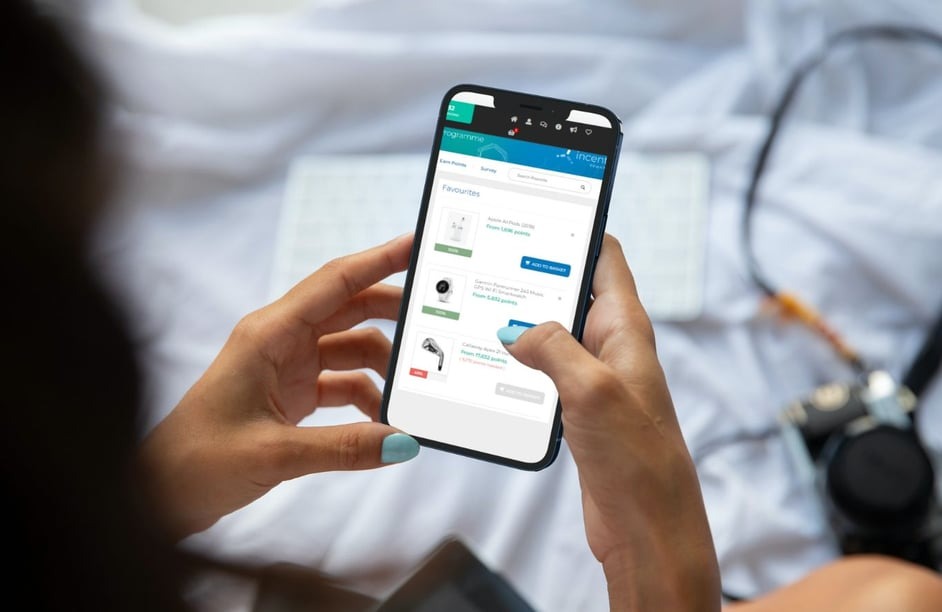
Rewarding positive behaviour cheat sheet.
Take a look below to inspire the positive behaviours you may wish to see within
your business.
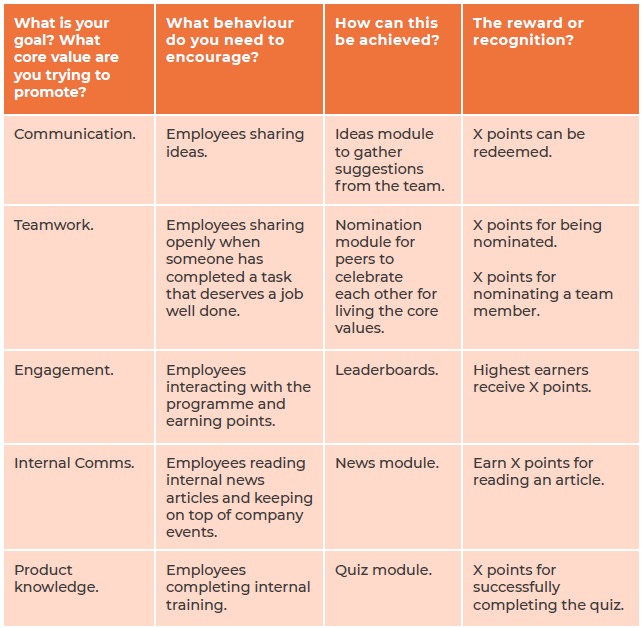
Create a reward scheme for employees today
If you’re ready to set up a reward scheme that truly motivates and engages your employees, we’re here to help. So why not reach out today to discover how we can design a customised employee reward programme that’s tailored to your company’s goals and values.



![*FREE GUIDE* How to implement a fantastic company culture in 6 steps Enter your business email for instant access. {{ include_custom_fonts({"Poppins":["Semi Bold"]}) }}](https://no-cache.hubspot.com/cta/default/5921162/interactive-188034983837.png)

